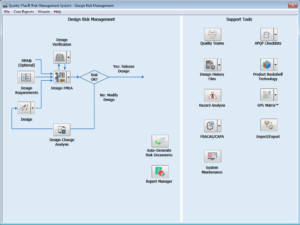Design Risk Management Overview
The primary task of the design engineer is to create a set of Product Design Specifications that define a product that will meet the Design Requirements. The Product Design Specifications contain the information required for manufacturing to build the product. They include dimensional and material specifications as well as required software code if applicable. Due to the wide variety of Design Requirements a product might have and the fact that some of the Design
Requirements can be competing; it is often impossible for the design engineer to define Product Design Specifications that define a product which will meet all the Design Requirements all the time.
The Quality Plus® Design Risk Management Module guides the design engineer through a structured decomposition of the design and enables the design engineer to capture critical information about the product. This information is placed in a Product Design Model for current use as well as future use for products of similar type.
Using the information in the custom Product Design Model as well as information from the Requirements Risk Assessment® if one has been performed, the Design Risk Management Module autogenerates a Design FMEA and supporting Design Verification Plan. After modifying the Occurrence Ratings of the Design FMEA with information gained from performance of the Design Verification Plan, the designer uses the Design FMEA output in combination with risk-based thinking to prioritize which design failures and Product Design Specifications must be worked on to achieve the greatest product risk/benefit ratio.
The Master Product Design Model found in the Quality Plus® Design Risk Management Module must not be confused with the static Master Design FMEA templates offered by many FMEA software vendors. The contents of the Quality Plus® Master Product Design Model are dynamically integrated with information in the Requirements Risk Management, Usage Risk Management and Manufacturing Process Risk Management Modules. The amount of information used from the Master Product Design Model for a new product design is dependent on a customized description of the new product provided to the Design Risk Management Module. It is not uncommon to create a customized Product Design Model and autogenerate the associated Design FMEA and Design Verification Plan in 2 hours or less.
Additional features of the Design Risk Management Module include Product Bookshelf Technology which captures design lessons learned, Product Design Specification Change Management and dynamic integration with the FRACAS/CAPA module for rapidly resolving product failures during manufacturing testing and in the field.
I have been working with Harpco Systems for 20 yrs and have seen how their products and services continue to improve to meet customer demands. Finding a disciplined approach to relate field performance to product design specifications is rare. There just is no uncomplicated way to do this correctly. Harpco’s approach handles all the complication internal to their software so the engineers can focus on other aspects of their job. Because the known failure mechanisms and causes are mapped, this information can be used for problem solving and driving continuous improvement in manufacturing.
Harpco Systems provides some of the most technologically advanced FMEA software tools on the market……. Harpco Systems has become known as the Modern FMEA for a reason. Its structured, simplified and sustainable.
“We used Q Plus to achieve Q1 and ISO 16949 successfully at the Ford Motor Co. Monroe BAO Plant. The software promoted linked documentation that prevented issues at internal and external audits. Assured the quality documents at the operations production level had all relevant and concurrent information that was reviewed in the program files. QPlus allowed the program members to create a baseline “Hot End Exhaust” database that produced linked documentation from the DFMEA to the production visual aids the operators used to perform correctly.”




